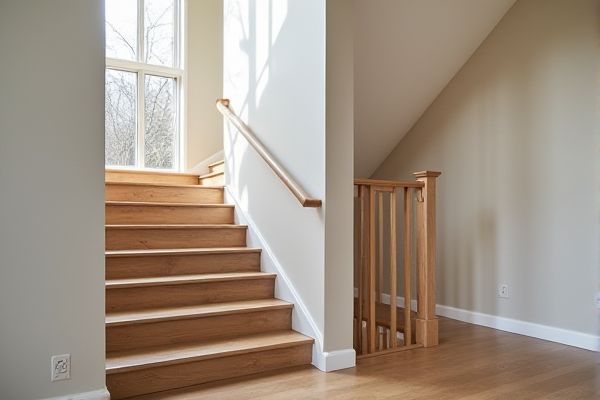
Continuous handrails provide uninterrupted support along stairs or ramps, enhancing safety and ease of use, especially for individuals with mobility challenges. Understanding the benefits of continuous versus segmented handrails can help you choose the best option for your safety needs; explore the rest of the article to learn more.
Table of Comparison
| Feature | Continuous Handrail | Segmented Handrail |
|---|---|---|
| Design | Single unbroken rail along the staircase | Handrail divided into multiple connected segments |
| Installation | Requires precise measurements and professional fitting | Modular installation; easier to replace individual segments |
| Safety | Provides uninterrupted grip minimizing fall risk | Potential grip interruptions at segment joints |
| Maintenance | Complex repairs; entire rail affected if damaged | Easy maintenance; damaged segment can be replaced individually |
| Cost | Generally higher due to custom fabrication | Usually lower; standardized parts reduce cost |
| Aesthetics | Sleek and seamless appearance | Visible joints may affect visual continuity |
| Durability | Strong and stable with continuous support | Dependent on joint quality; slightly less sturdy |
Introduction to Handrail Systems
Continuous handrail systems provide an unbroken, smooth surface that enhances safety and support along stairways or ramps. Segmented handrails consist of individual sections joined together, often used in complex or curved architectural designs where flexibility is needed. Choosing the right handrail system for your space impacts both functionality and compliance with building codes.
What is a Continuous Handrail?
A continuous handrail is a single, uninterrupted rail that extends along the entire length of a staircase or ramp, providing consistent support and safety. Its seamless design eliminates gaps or breaks, which reduces the risk of slips or falls and enhances user comfort during ascent or descent. Choosing a continuous handrail for your space ensures compliance with modern building codes and improves accessibility for all users.
What is a Segmented Handrail?
A segmented handrail consists of multiple straight sections joined together, often used in staircases with landings or angled turns to accommodate changes in direction. This design allows for easier installation and customization on complex stair layouts compared to continuous handrails. Segmented handrails provide flexible support while maintaining safety standards in residential and commercial buildings.
Key Differences Between Continuous and Segmented Handrails
Continuous handrails provide an unbroken, smooth grip along stairs or ramps, enhancing safety by reducing hand slippage and supporting uninterrupted movement. Segmented handrails consist of multiple sections joined together, allowing for easier installation around obstacles but potentially introducing gaps that may affect grip security. Continuous handrails are preferred in commercial and high-traffic environments for their durability and compliance with ADA standards, while segmented handrails offer flexibility in design and cost-effectiveness for residential applications.
Aesthetic Impact: Seamless vs. Sectional Designs
Continuous handrails offer a sleek, seamless design that enhances the aesthetic flow of your space by eliminating visual breaks. Segmented handrails, composed of distinct sections, create a more modular look that can complement traditional or industrial styles. Choosing between continuous and segmented designs directly influences the visual harmony and style statement of your interior or exterior architecture.
Installation Process and Complexity
Continuous handrails require precise measurements and seamless welding or joining techniques to ensure a smooth and uninterrupted finish, making the installation process more complex and time-consuming. Segmented handrails consist of multiple sections connected by brackets or fittings, allowing easier handling, faster installation, and simplified adjustments on-site. The complexity of installing segmented handrails is generally lower due to modular components, while continuous handrails demand skilled labor and meticulous alignment for a flawless appearance.
Safety and Accessibility Considerations
Continuous handrails provide consistent support along the entire length of ramps or stairs, enhancing safety by reducing the risk of falls and offering steady guidance for users with mobility impairments. Segmented handrails, however, may create gaps that hinder accessibility, making it challenging for individuals with disabilities or limited grip strength to maintain continuous contact. Building codes and ADA standards often favor continuous handrails to ensure safer, more accessible environments for all users.
Maintenance and Durability Comparison
Continuous handrails offer superior durability due to fewer joints, which minimizes points of wear and potential failure, resulting in lower long-term maintenance costs. Segmented handrails, composed of multiple sections, often require more frequent inspections and repairs at connection points where corrosion, loosening, or damage is more likely to occur. Materials such as stainless steel or aluminum enhance the lifespan and reduce maintenance needs for both types, but the seamless construction of continuous handrails generally provides a more resilient solution in high-traffic or outdoor environments.
Cost Analysis: Continuous vs. Segmented Handrails
Continuous handrails generally offer lower installation and maintenance costs compared to segmented handrails, as they require fewer joints and connectors, reducing labor and material expenses. Segmented handrails may incur higher costs due to the complexity of assembling multiple sections and increased potential for wear at joints, leading to more frequent repairs. Your choice impacts long-term budget efficiency, with continuous handrails providing a cost-effective solution for durability and ease of upkeep.
Choosing the Right Handrail for Your Project
Selecting the right handrail for your project depends on factors like aesthetics, durability, and installation complexity. Continuous handrails offer uninterrupted support and a sleek design ideal for long staircases, while segmented handrails provide flexibility for complex layouts and easier maintenance. Your choice should align with the architectural style and safety requirements to ensure optimal functionality and visual appeal.
 homyna.com
homyna.com